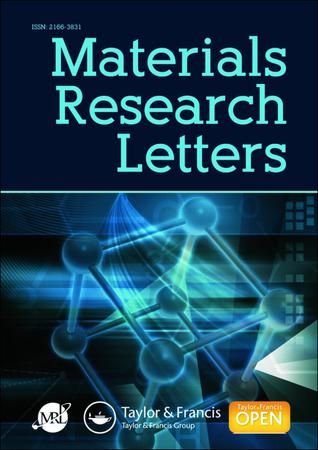采用激光粉末床熔合法制备了新型非等原子TiZrHfNbTaMo生物高熵合金
IF 8.6
1区 材料科学
Q1 MATERIALS SCIENCE, MULTIDISCIPLINARY
引用次数: 5
摘要
本研究利用激光粉末床融合(LPBF)开发了一种非等原子Ti28.33Zr28.33Hf28.33Nb6.74Ta6.74Mo1.55超固态固溶体BioHEA,以充分发挥其作为BioHEA的潜力。我们成功地显著抑制了元素偏析,从而通过激活逐层外延生长产生了类似单晶的织构。在类似BioHEA的单晶中实现了相对低的杨氏模量。此外,LPBF制造的BioHEA表现出显著更高的屈服应力(1355–1426 MPa),这是由于与具有明显偏析(949 MPa)和良好的生物相容性。这是首次报道通过LPBF实现具有低模量、优异的强度-延展性平衡和良好生物相容性的BioHEA。图形摘要影响声明本研究使用激光粉末床融合实现了超固态固溶和单晶状TiZrHfNbTaMo生物高熵合金,使其在定向方向上具有低杨氏模量、优异的强度-延展性平衡和良好的细胞相容性。本文章由计算机程序翻译,如有差异,请以英文原文为准。
Novel single crystalline-like non-equiatomic TiZrHfNbTaMo bio-high entropy alloy (BioHEA) developed by laser powder bed fusion
This study developed a non-equiatomic Ti28.33Zr28.33Hf28.33Nb6.74Ta6.74Mo1.55 super-solid solutionized BioHEA using laser powder bed fusion (LPBF) to reach the full potential as BioHEA. We succeeded in significant suppression of elemental segregation, thus, resulting in a single crystalline-like texture by activating layer-to-layer epitaxial growth. Relatively low Young’s modulus was achieved in the single crystalline-like BioHEA. Moreover, LPBF-fabricated BioHEA exhibited significantly higher yield stress (1355–1426 MPa) due to the effective solid solution hardening compared to as-cast counterpart with marked segregation (949 MPa), and good biocompatibility. This is first report achieving BioHEA with low modulus, excellent strength-ductility balance, and good biocompatibility via LPBF. GRAPHICAL ABSTRACT IMPACT STATEMENT This study achieved super-solid-solutionized and single crystalline-like TiZrHfNbTaMo bio-high entropy alloy using laser powder bed fusion, resulting in low Young’s modulus along <001> oriented direction, excellent strength-ductility balance, and good cytocompatibility.
求助全文
通过发布文献求助,成功后即可免费获取论文全文。
去求助
来源期刊

Materials Research Letters
Materials Science-General Materials Science
CiteScore
12.10
自引率
3.60%
发文量
98
审稿时长
3.3 months
期刊介绍:
Materials Research Letters is a high impact, open access journal that focuses on the engineering and technology of materials, materials physics and chemistry, and novel and emergent materials. It supports the materials research community by publishing original and compelling research work. The journal provides fast communications on cutting-edge materials research findings, with a primary focus on advanced metallic materials and physical metallurgy. It also considers other materials such as intermetallics, ceramics, and nanocomposites. Materials Research Letters publishes papers with significant breakthroughs in materials science, including research on unprecedented mechanical and functional properties, mechanisms for processing and formation of novel microstructures (including nanostructures, heterostructures, and hierarchical structures), and the mechanisms, physics, and chemistry responsible for the observed mechanical and functional behaviors of advanced materials. The journal accepts original research articles, original letters, perspective pieces presenting provocative and visionary opinions and views, and brief overviews of critical issues.
 求助内容:
求助内容: 应助结果提醒方式:
应助结果提醒方式:


